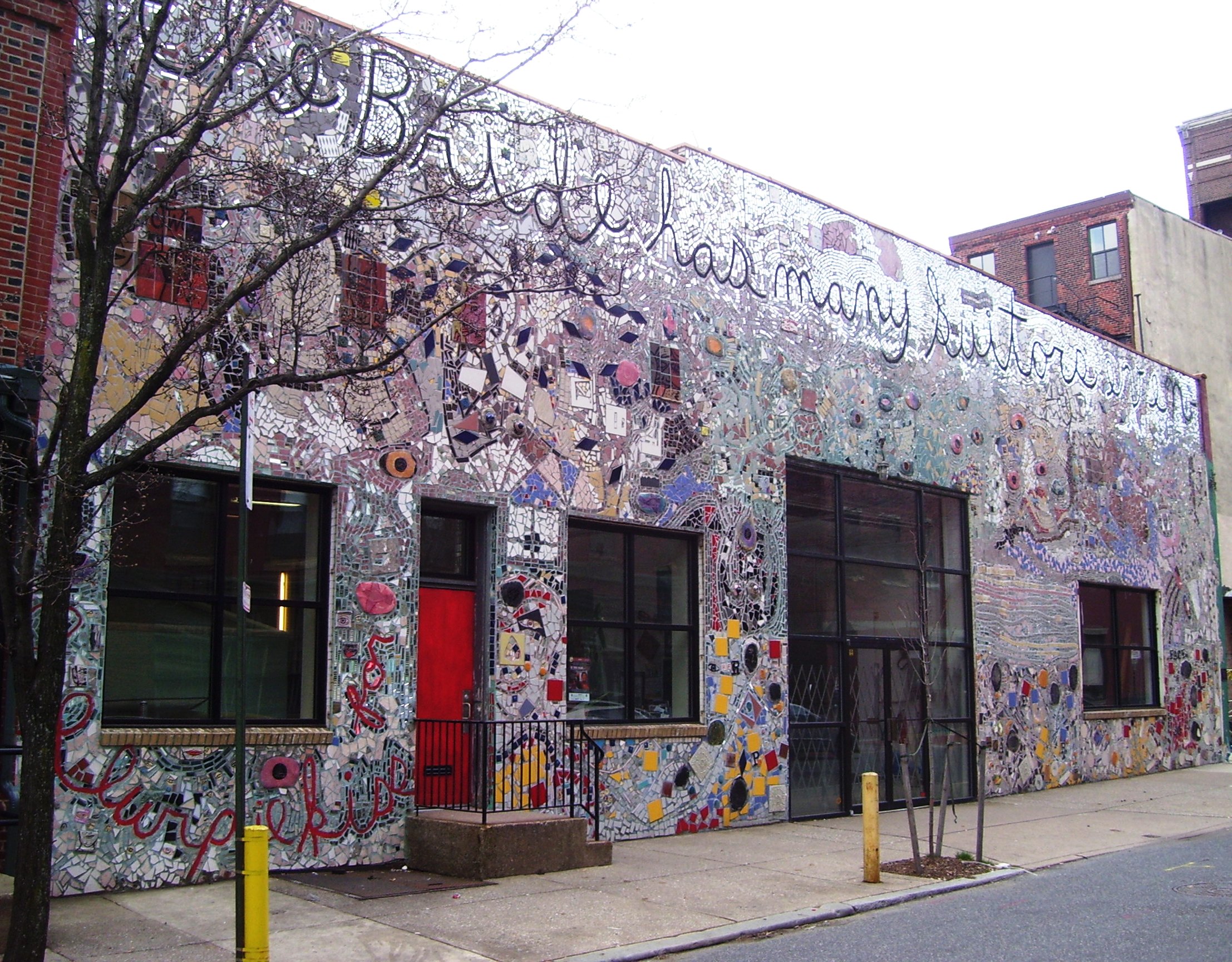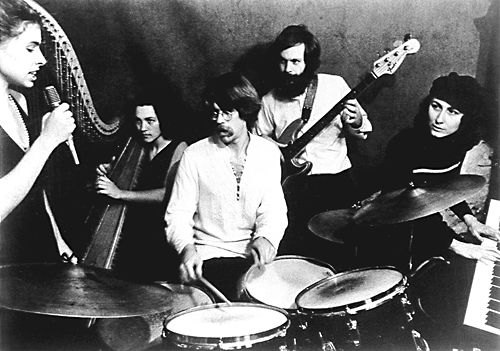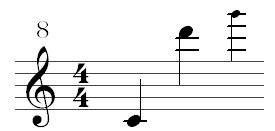|
Musica Orbis
Musica Orbis was an American electric chamber music quintet based in Philadelphia, performing between 1972 and 1979. Instrumentation included voices, harp, flute, cello, acoustic and electric bass, drums, marimba, vibes, synthesizer, organ, pump organ, knee harp, wooden recorder, bells, hand percussion, Fender Rhodes, and piano. Formation and debut Musica Orbis was founded in late spring 1972 by singer/songwriter Kitty Brazelton and Tom Stephenson (percussion, cello) on the Swarthmore College campus. Susan Gelletly (keyboards) and Caroline "Caille" Colburn (harp) then joined, followed by David Clark (percussion), James J. Kelly (guitars) and William Pastuszek Jr. (saxophones & bass). The group debuted as a septet on April 15, 1973, in Bond Hall on the Swarthmore College campus. Before their official debut, they opened for jazz-rock Good God and Blue Öyster Cult in Clothier Hall, Swarthmore College in March 1973. In fall 1973 Musica Orbis reduced from septet to quintet w ... [...More Info...] [...Related Items...] OR: [Wikipedia] [Google] [Baidu] |
Philadelphia
Philadelphia, often called Philly, is the largest city in the Commonwealth of Pennsylvania, the sixth-largest city in the U.S., the second-largest city in both the Northeast megalopolis and Mid-Atlantic regions after New York City. Since 1854, the city has been coextensive with Philadelphia County, the most populous county in Pennsylvania and the urban core of the Delaware Valley, the nation's seventh-largest and one of world's largest metropolitan regions, with 6.245 million residents . The city's population at the 2020 census was 1,603,797, and over 56 million people live within of Philadelphia. Philadelphia was founded in 1682 by William Penn, an English Quaker. The city served as capital of the Pennsylvania Colony during the British colonial era and went on to play a historic and vital role as the central meeting place for the nation's founding fathers whose plans and actions in Philadelphia ultimately inspired the American Revolution and the nation's inde ... [...More Info...] [...Related Items...] OR: [Wikipedia] [Google] [Baidu] |
Fender Rhodes
The Rhodes piano (also known as the Fender Rhodes piano) is an electric piano invented by Harold Rhodes, which became popular in the 1970s. Like a conventional piano, the Rhodes generates sound with keys and hammers, but instead of strings, the hammers strike thin metal tines, which vibrate next to an electromagnetic pickup. The signal is then sent through a cable to an external keyboard amplifier and speaker. The instrument evolved from Rhodes's attempt to manufacture pianos while teaching recovering soldiers during World War II. Development continued after the war and into the following decade. In 1959, Fender began marketing the Piano Bass, a cut-down version; the full-size instrument did not appear until after Fender's sale to CBS in 1965. CBS oversaw mass production of the Rhodes piano in the 1970s, and it was used extensively through the decade, particularly in jazz, pop, and soul music. It was less used in the 1980s because of competition with polyphonic and digital ... [...More Info...] [...Related Items...] OR: [Wikipedia] [Google] [Baidu] |
CBGB
CBGB was a New York City music club opened in 1973 by Hilly Kristal in Manhattan's East Village. The club was previously a biker bar and before that was a dive bar. The letters ''CBGB'' were for '' Country'', '' BlueGrass'', and '' Blues'', Kristal's original vision, yet CBGB soon became a famed venue of punk rock and new wave bands like the Ramones, Television, Patti Smith Group, Blondie, and Talking Heads. From the early 1980s onward, CBGB was known for hardcore punk. One storefront beside CBGB became the "CBGB Record Canteen", a record shop and café. In the late 1980s, "CBGB Record Canteen" was converted into an art gallery and second performance space, "CB's 313 Gallery". CB's Gallery was played by music artists of milder sounds, such as acoustic rock, folk, jazz, or experimental music, such as Dadadah, Kristeen Young and Toshi Reagon, while CBGB continued to showcase mainly hardcore punk, post punk, metal, and alternative rock. 313 Gallery was also the host location ... [...More Info...] [...Related Items...] OR: [Wikipedia] [Google] [Baidu] |
The Real Paper
''The Real Paper'' was a Boston-area alternative weekly newspaper with a circulation in the tens of thousands. It ran from August 2, 1972, to June 18, 1981, often devoting space to counterculture and alternative politics of the early 1970s. The offices were in Cambridge, Massachusetts. History ''The Cambridge Phoenix'' was born on October 9, 1969, founded by Jeffrey Tarter. In the summer of 1972, Richard Missner, owner of what was then simply called "The Phoenix," fired editor Harper Barnes in a journalistic dispute. A union was formed and almost all of the staff went on strike. An agreement was reached within two weeks, without Barnes' reinstatement. Soon afterwards, the staff was informed of the purchase of the paper – its name and goodwill – by Stephen Mindich, owner of the more established (and more commercial) competitor ''Boston After Dark''. Hoping to eliminate his direct competition. Mindich renamed his paper ''The Boston Phoenix After Dark,'' later shortened back to ... [...More Info...] [...Related Items...] OR: [Wikipedia] [Google] [Baidu] |
Painted Bride Art Center
The Painted Bride Art Center, sometimes referred to informally as The Bride, is a non-profit artist-centered performance space and gallery particularly oriented to presenting the work of local Philadelphia artists, which presents dance, jazz, world, folk and electronic music, visual arts, theatre and performance art, poetry and spoken word performances. It is located at 5212 Market Street in the West Philadelphia neighborhood of Philadelphia, Pennsylvania, The Painted Bride was founded as a gallery space in an old bridal shop on South Street in 1969 by Gerry Givnish, Sylvia and Larry Konigsberg, Frank Vavricka, A. John Kammer, and Deryl Mackie. Its name derives from a mannequin placed in the shop's window, which became an attraction as people came by to see what provocative outfit it was wearing, or what lewd position it was placed in. In 1973, the gallery gave rise to the ''Painted Bride Quarterly'', a poetry and literary journal. In 1977, having received funding from the Co ... [...More Info...] [...Related Items...] OR: [Wikipedia] [Google] [Baidu] |
Wilma Theater (Philadelphia)
The Wilma Theater is a non-profit theater company located at 265 S. Broad Street at the corner of Spruce Street in the Avenue of the Arts area of Center City, Philadelphia. The company's current 296-seat theater opened in 1996 and was designed by Hugh Hardy. History The Wilma Theater began in 1973 as the "Wilma Project", founded to produce original material and to develop community-orient artists. The name "Wilma" refers to an imaginary oppressed sister of Shakespeare created by Virginia Woolf Adeline Virginia Woolf (; ; 25 January 1882 28 March 1941) was an English writer, considered one of the most important modernist 20th-century authors and a pioneer in the use of stream of consciousness as a narrative device. Woolf was born .... Blanka Zizka and Jiri Zizka from Czechoslovakia joined the project in 1979 as artists-in-residence, and later took over artistic leadership, changing the name to the Wilma Theater. The company staged their productions at a variety of d ... [...More Info...] [...Related Items...] OR: [Wikipedia] [Google] [Baidu] |
Blue Öyster Cult
Blue Öyster Cult ( ; sometimes abbreviated BÖC or BOC) is an American rock band formed on Long Island in Stony Brook, New York, in 1967, and best known for the singles " (Don't Fear) The Reaper", " Burnin' for You", and "Godzilla". The band has sold 25 million records worldwide, including 7 million in the United States alone. Blue Öyster Cult‘s music videos, especially "Burnin' for You", received heavy rotation on MTV when the music television network premiered in 1981, cementing the band's contribution to the development and success of the music video in modern popular culture. Blue Öyster Cult's longest-lasting and the most commercially successful lineup included Donald "Buck Dharma" Roeser (lead guitar, vocals), Eric Bloom (lead vocals, " stun guitar", keyboards, synthesizer), Allen Lanier (keyboards, rhythm guitar), Joe Bouchard (bass, vocals, keyboards), and Albert Bouchard (drums, percussion, vocals, miscellaneous instruments). The band's current lineup stil ... [...More Info...] [...Related Items...] OR: [Wikipedia] [Google] [Baidu] |
Swarthmore College
Swarthmore College ( , ) is a private liberal arts college in Swarthmore, Pennsylvania. Founded in 1864, with its first classes held in 1869, Swarthmore is one of the earliest coeducational colleges in the United States. It was established as a college "under the care of Friends, ndat which an education may be obtained equal to that of the best institutions of learning in our country." By 1906, Swarthmore had dropped its religious affiliation and officially became non-sectarian. Swarthmore is a member of the Tri-College Consortium, a cooperative academic arrangement with Bryn Mawr and Haverford College. Swarthmore also is affiliated with the University of Pennsylvania through the Quaker Consortium, which allows for students to cross-register for classes at all four institutions. Swarthmore offers over 600 courses per year in more than 40 areas of study, including an ABET-accredited engineering program that culminates in a Bachelor of Science in engineering. Swarthmore has ... [...More Info...] [...Related Items...] OR: [Wikipedia] [Google] [Baidu] |
Kitty Brazelton
Kitty Brazelton (born 1951 in Cambridge, Massachusetts) is a New York-based American composer, bandleader, improviser, singer/songwriter, and instrumentalist. She has released albums and fronted bands across varied genres, including contemporary classical, electronic music, pop, art rock, punk, and avant-garde jazz. She was awarded the 2012 Carl von Ossietsky Composition Prize for ''Storm'', a choral setting of Psalm 104 featuring Brazelton's own retranslation''.'' Her opera ''Art of Memory'' was awarded the 2015 Grant for Female Composers from Opera America. Biography Personal life Brazelton was born on October 5, 1951 in Cambridge, Massachusetts, United States. Her father was pediatrician and author T. Berry Brazelton. Brazelton attended Swarthmore College and received a doctorate in music from Columbia University in 1994. She was formerly married to jazz critic and president of the Jazz Journalists Association Howard Mandel and currently teaches composition at Bennin ... [...More Info...] [...Related Items...] OR: [Wikipedia] [Google] [Baidu] |
Woodcut Of Musica Orbis Instruments
Woodcut is a relief printing technique in printmaking. An artist carves an image into the surface of a block of wood—typically with gouges—leaving the printing parts level with the surface while removing the non-printing parts. Areas that the artist cuts away carry no ink, while characters or images at surface level carry the ink to produce the print. The block is cut along the wood grain (unlike wood engraving, where the block is cut in the end-grain). The surface is covered with ink by rolling over the surface with an ink-covered roller ( brayer), leaving ink upon the flat surface but not in the non-printing areas. Multiple colors can be printed by keying the paper to a frame around the woodblocks (using a different block for each color). The art of carving the woodcut can be called "xylography", but this is rarely used in English for images alone, although that and "xylographic" are used in connection with block books, which are small books containing text and images in ... [...More Info...] [...Related Items...] OR: [Wikipedia] [Google] [Baidu] |
Recorder (musical Instrument)
The recorder is a family of woodwind musical instruments in the group known as ''internal duct flutes'': flutes with a whistle mouthpiece, also known as fipple flutes. A recorder can be distinguished from other duct flutes by the presence of a thumb-hole for the upper hand and seven finger-holes: three for the upper hand and four for the lower. It is the most prominent duct flute in the western classical tradition. Recorders are made in various sizes with names and compasses roughly corresponding to various vocal ranges. The sizes most commonly in use today are the soprano (also known as descant, lowest note C5), alto (also known as treble, lowest note F4), tenor (lowest note C4), and bass (lowest note F3). Recorders were traditionally constructed from wood or ivory. Modern professional instruments are almost invariably of wood, often boxwood; student and scholastic recorders are commonly of molded plastic. The recorders' internal and external proportions vary, but the bore ... [...More Info...] [...Related Items...] OR: [Wikipedia] [Google] [Baidu] |
Harp
The harp is a stringed musical instrument that has a number of individual string (music), strings running at an angle to its sound board (music), soundboard; the strings are plucked with the fingers. Harps can be made and played in various ways, standing or sitting, and in orchestras or concerts. Its most common form is triangular in shape and made of wood. Some have multiple rows of strings and pedal attachments. Ancient depictions of harps were recorded in Current-day Iraq (Mesopotamia), Iran (Iran, Persia), and Egypt, and later in India and China. By medieval times harps had spread across Europe. Harps were found across the Americas where it was a popular Folk music, folk tradition in some areas. Distinct designs also emerged from the African continent. Harps have symbolic political traditions and are often used in logos, including in Ireland. History Harps have been known since antiquity in Asia, Africa, and Europe, dating back at least as early as 3000 BCE. The ... [...More Info...] [...Related Items...] OR: [Wikipedia] [Google] [Baidu] |





.png)



